Description
GLA Macros & Micros Nectar Bottle Set - Complete Nutrient Solution for Freshwater Planted Aquariums (2 x 1000 ML Bottles)
Achieve a thriving, vibrant aquascape with the combined power of GLA Macros Nectar and GLA Micros Nectar. This premium liquid fertilizer set delivers a comprehensive blend of macro and micronutrients designed to meet the specific needs of your aquatic plants. With GLA’s advanced nutrient formulations, your aquarium will benefit from balanced, consistent nutrient delivery, promoting lush plant growth, strong root systems, and vibrant colors.
The set includes one bottle of GLA Macros Nectar, providing essential macronutrients like nitrate, phosphate, potassium, and magnesium, and one bottle of GLA Micros Nectar, which supplies crucial micronutrients such as iron, manganese, zinc, and boron. Together, these fertilizers work synergistically to create the ideal environment for aquatic plant health and vitality, whether you're cultivating a high-tech, densely planted tank or maintaining a balanced, low-light setup.
Key Features:
- Complete Nutrient Profile: GLA Macros Nectar delivers essential macronutrients (Nitrate, Phosphate, Potassium, Magnesium), while GLA Micros Nectar provides critical micronutrients (Iron, Manganese, Zinc, Boron, and more). This combination ensures optimal nutrient absorption and plant health, supporting robust growth and color vibrancy.
- Flexible Dosing Strategies: The set includes four distinct dosing levels—Lean, Balanced, High-Tech, and Non-Limiting—allowing you to fine-tune nutrient delivery based on your aquarium’s lighting, CO2 levels, and plant density. You can choose between daily dosing, alternating days dosing, or front-loading dosing based on your preference and tank requirements.
- High Stability & Concentration: Both GLA Macros and Micros Nectar are highly concentrated and stable formulations, providing long-lasting nutrient delivery with minimal risk of nutrient precipitation or instability. This ensures your plants receive consistent nutrition over time, reducing the need for frequent adjustments.
- Professional-Grade Quality: Developed by experts in aquatic plant nutrition, these fertilizers are formulated using the highest quality ingredients and rigorously tested to meet strict industry standards. Each dose is designed to promote vigorous plant health and sustained growth in freshwater planted aquariums.
- 100% USA Crafted with Purity: At GLA, our liquid fertilizers are proudly developed and produced 100% in the USA, ensuring the highest standards of quality and performance. We never add artificial dyes or green coloring to alter the appearance. Our Micros & Macros Nectar formulas retain their natural, beautiful, nectar-like color with crystal-clear transparency—reflecting the purity and precision of the carefully balanced nutrients we use to promote optimal plant health.
GLA Macros Nectar - Macronutrient Solution:
- Guaranteed Analysis:
- Total Nitrogen (N): 2.00%
- Available Phosphate (P₂O₅): 1.00%
- Soluble Potash (K₂O): 10.00%
- Total Magnesium (Mg): 0.50%
- Derived from: Potassium Nitrate, Monopotassium Phosphate, Sulfate of Potash, Magnesium Sulfate.
GLA Micros Nectar - Micronutrient Solution:
- Guaranteed Analysis:
- Total Iron (Fe): 0.14%
- Boron (B): 0.014%
- Chelated Manganese (Mn): 0.07%
- Molybdenum (Mo): 0.0001%
- Chelated Copper (Cu): <0.001%
- Chelated Zinc (Zn): 0.007%
- Derived from: Iron DTPA, Boric Acid, Manganese EDTA, Sodium Molybdate, Copper EDTA, Zinc EDTA.
Dosing Levels & Guidelines:
We designed GLA Micros & Macros Nectar with 4 dosing levels (Lean, Balanced, High-Tech, & Non-Limiting) & 2 Dosing Frequencies (Daily 7x/week or Alternating Day dosing 3-4x/week). Select the dosing level that best fits your nature aquarium and the dosing frequency that best accommodates your lifestyle or overall tank maintenance/fertilizer strategies. For an explanation of the 4 dosing levels and 2 dosing frequencies, scroll to check out our FAQ's below and review our complete guide to GLA Nectar to learn everything you need to know to get started, grow & maintain a thriving & successful aquascape.
Daily Dosing (7 days/week):
- Lean Dosing (Low light/growth rate): 0.25ml per 10 gallons (1.25ml/50 gallons)
- Balanced Dosing (Medium light/growth rate): 0.5ml per 10 gallons (2.5ml/50 gallons)
- High-Tech Dosing (High light/growth rate): 1ml per 10 gallons (5ml/50 gallons)
- Non-Limiting Dosing (Very high light/growth rate): 2ml per 10 gallons (10ml/50 gallons)
Dosing on Alternating Days (3 to 4 days/week):
- Lean Dosing: 0.5ml per 10 gallons (2.5ml/50 gallons) – Dose Micros & Macros on alternating days, 3 days each. Optional: Front-loading Dose 0.25ml per 10 gallons on day 7 after a 50% water change.
- Balanced Dosing: 1ml per 10 gallons (5ml/50 gallons) – Dose Micros & Macros on alternating days, 3 days each. Optional: Front-loading Dose 0.5ml per 10 gallons on day 7 after a 50% water change.
- High-Tech Dosing: 2ml per 10 gallons (10ml/50 gallons) – Dose Micros & Macros on alternating days, 3 days each. Optional: Front-loading Dose 1ml per 10 gallons on day 7 after a 50% water change.
- Non-Limiting Dosing: 4ml per 10 gallons (20ml/50 gallons) – Dose Micros & Macros on alternating days, 3 days each. Optional: Front-loading Dose 2ml per 10 gallons on day 7 after a 50% water change.
Why Use GLA Macros & Micros Nectar Together?
Combining GLA Macros and Micros Nectar allows for a complete and balanced nutrient regimen that promotes healthy plant development at every stage. Macronutrients provide the bulk of a plant's nutritional needs, while micronutrients ensure proper enzymatic function, photosynthesis, and color vibrancy. Used together, these fertilizers enable you to achieve lush, thriving aquascapes with ease.
Included Sizes:
- GLA Macros Nectar: 1000ml (32 FL OZ)
- GLA Micros Nectar: 1000ml (32 FL OZ)
By using GLA Macros & Micros Nectar in tandem, you’ll be providing your plants with everything they need for optimal growth, color enhancement, and long-term stability. This bottle set is perfect for aquarists who seek precision, quality, and results in their aquarium care routine.
- For an explanation of the 4 dosing levels and 2 dosing frequencies, scroll to check out our FAQ's below and also review our complete guide to GLA Nectar to learn everything you need to get started, grow & maintain a thriving & successful aquascape.
- Use our liquid fertilizer dosing and recommended bottle size calculators to determine which bottle size to purchase, and to tailor your dosing based on tank size and aquascape, ensuring precise nutrient delivery for lean, balanced, high-tech, or non-limiting setups.
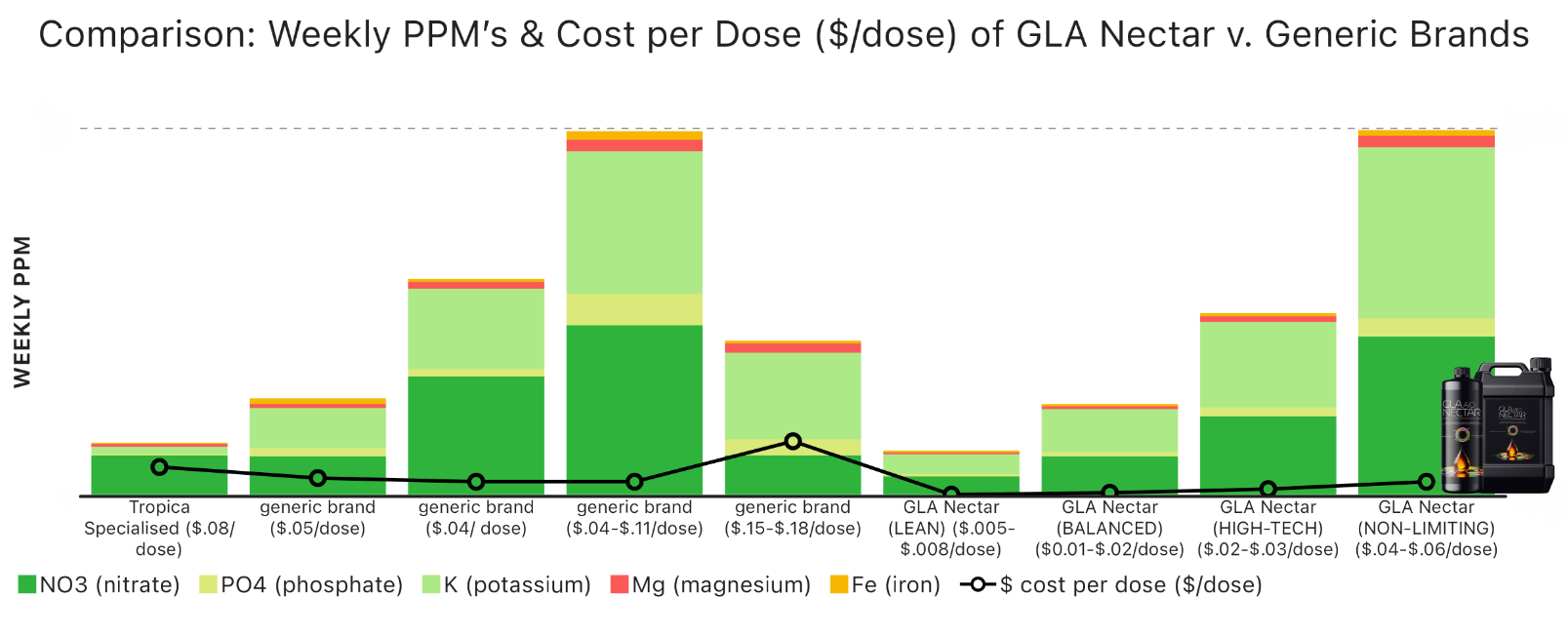
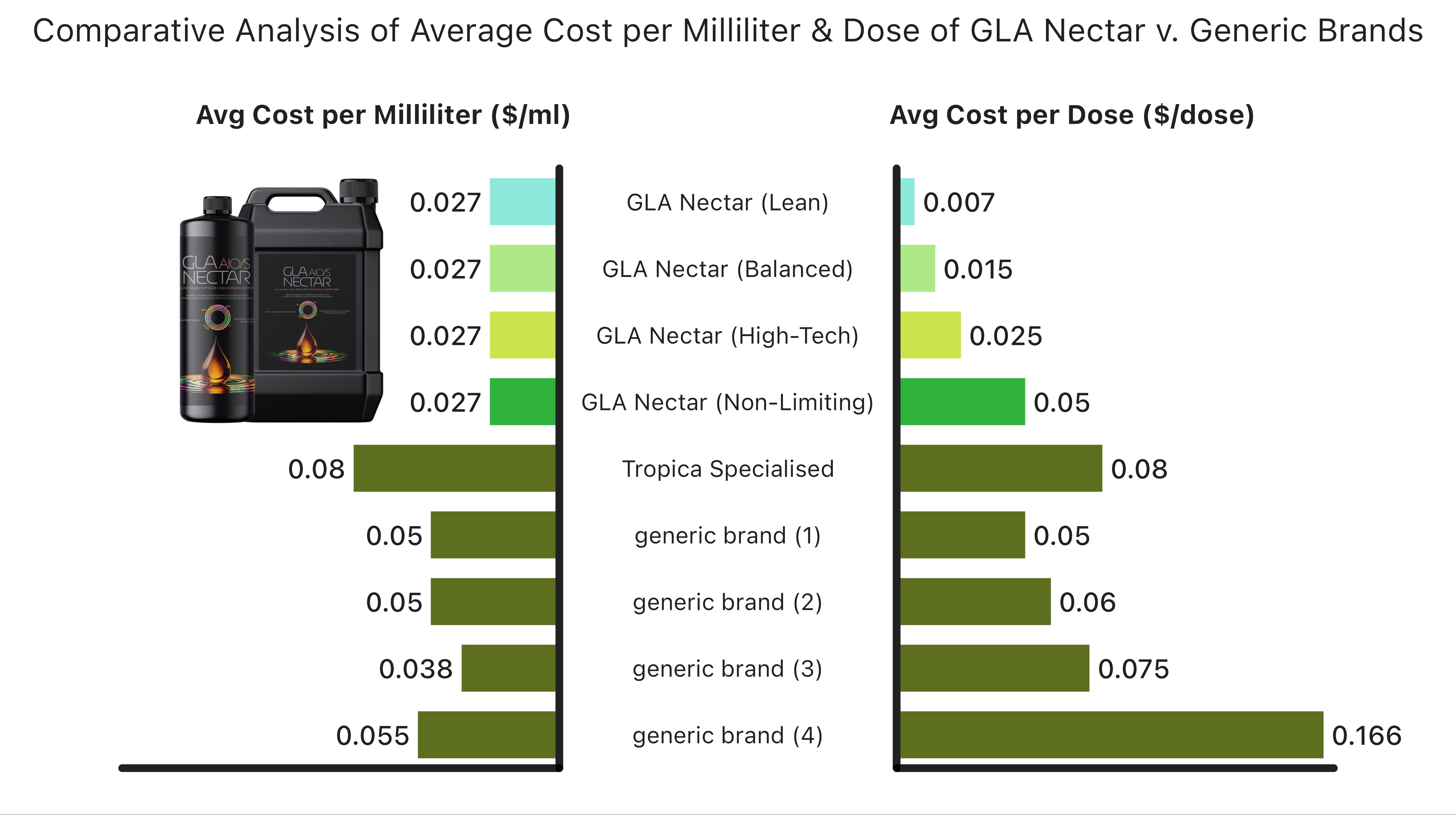
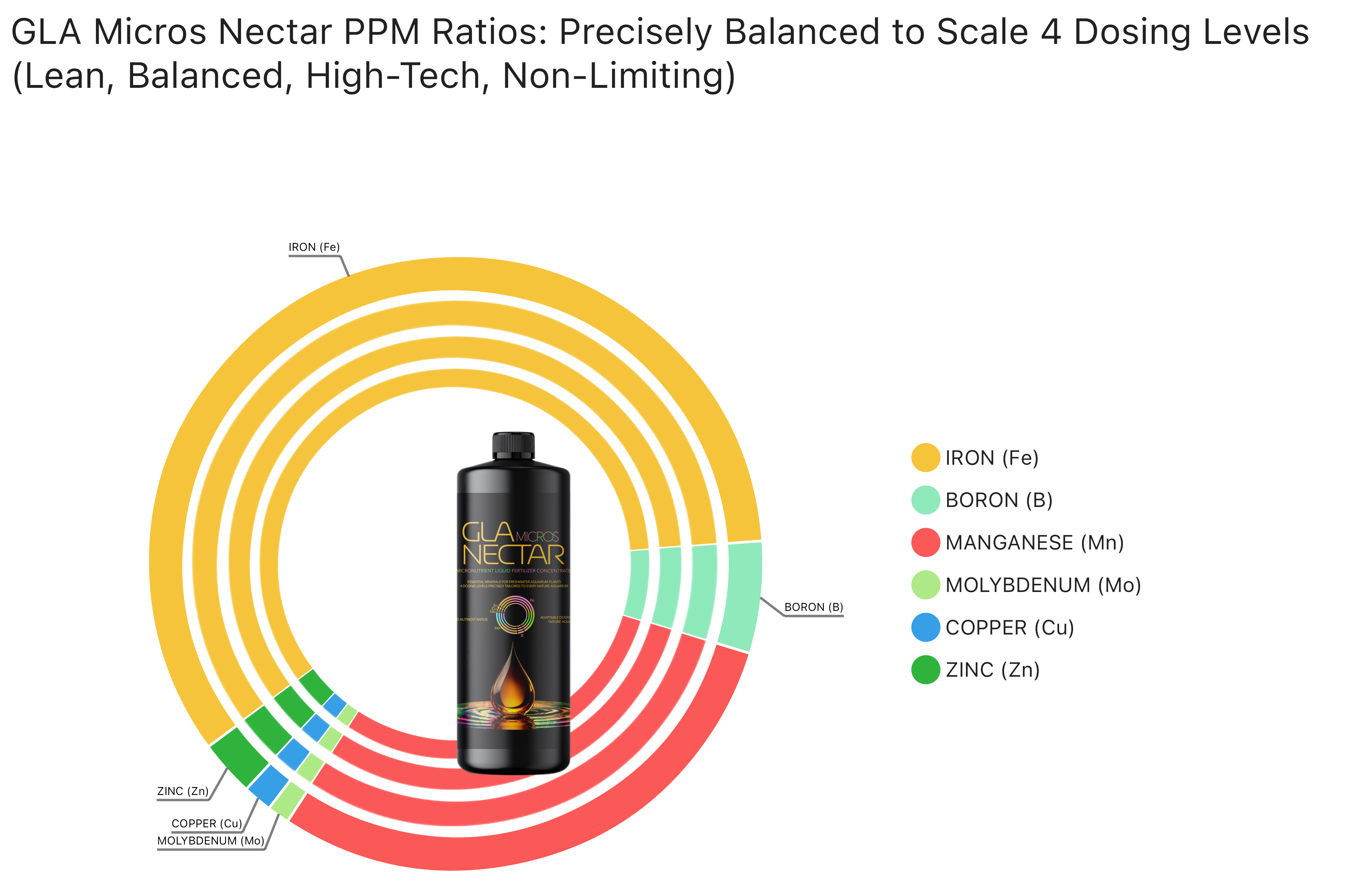
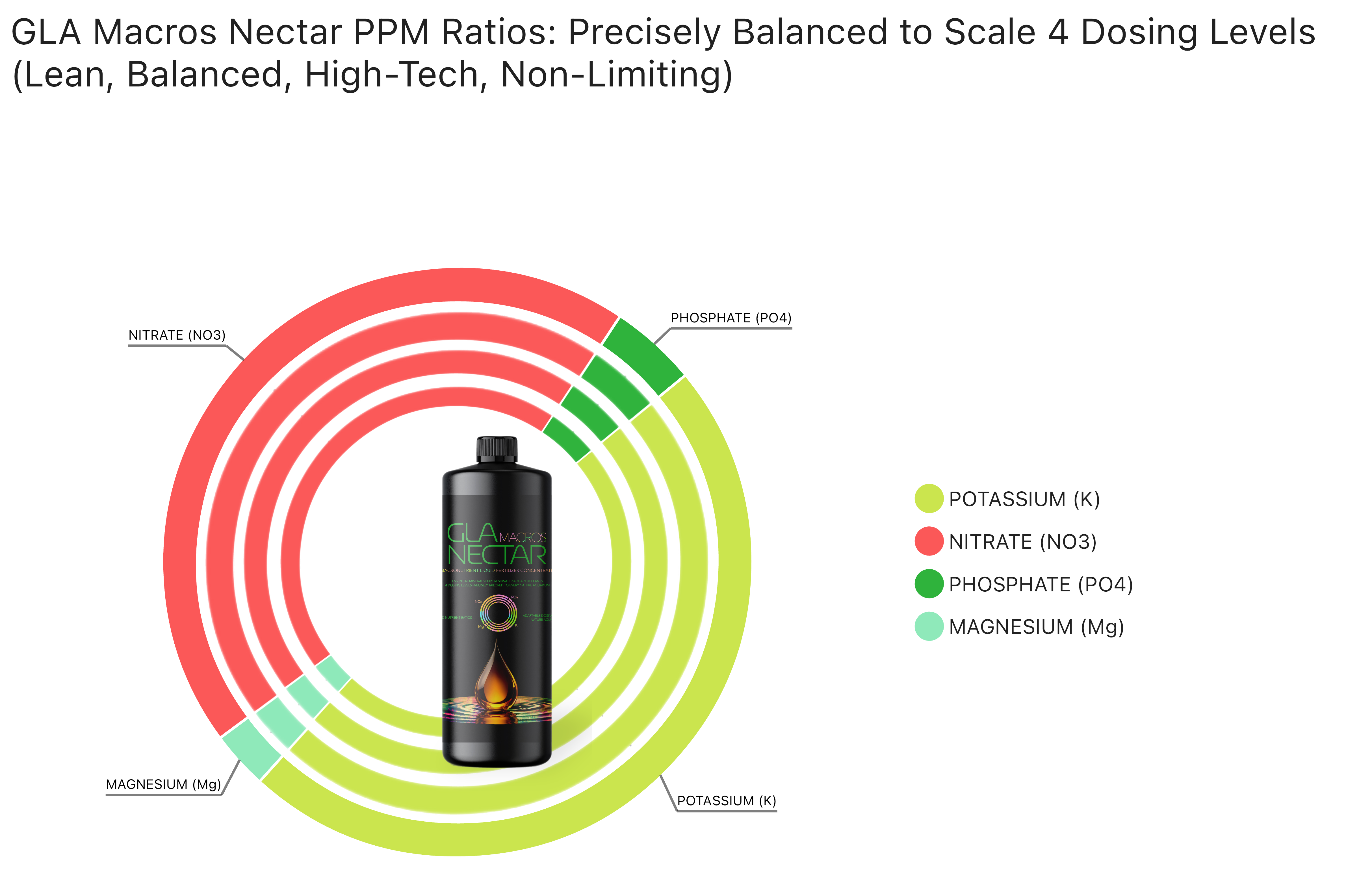
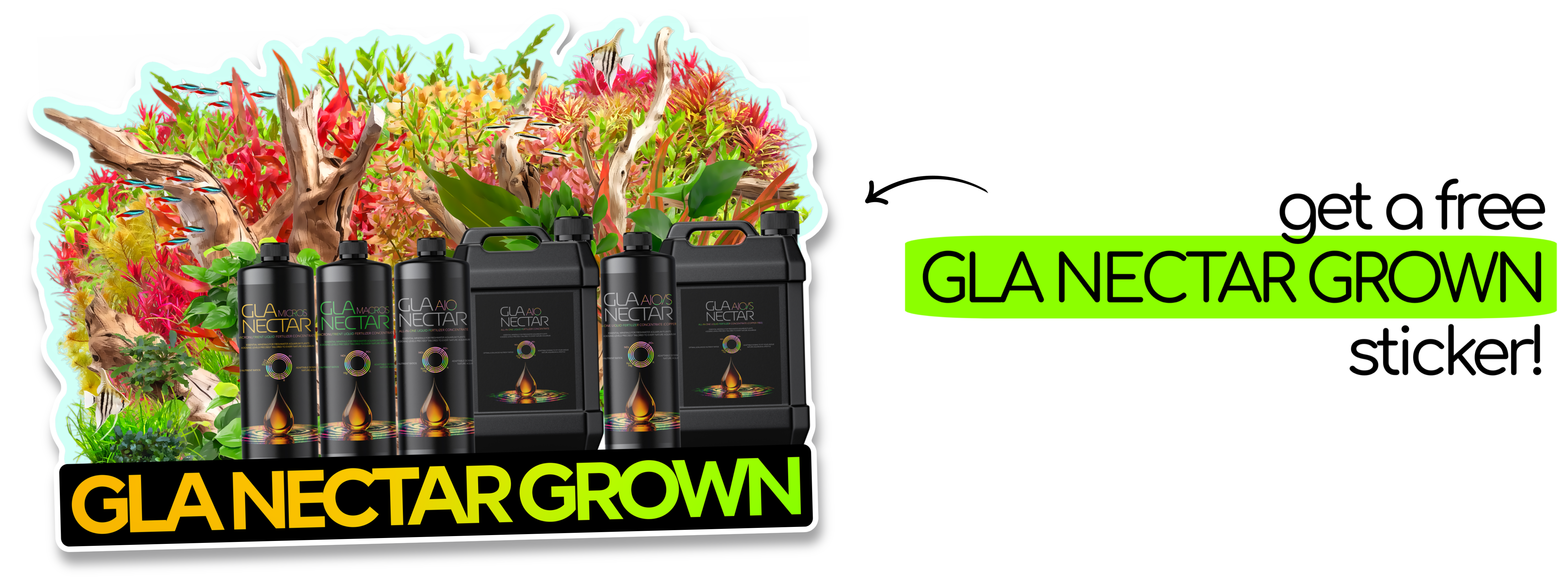
Frequently Asked Questions (FAQ):
* check out our comprehensive guide to GLA Nectar Fertilizer for more GLA Nectar FAQ's, further exploration of dosing levels, dosing frequencies & strategies, cost analysis, and more!
What are the different dosing levels, and how do I choose the right one?
GLA offers four dosing levels: Lean, Balanced, High-Tech, and Non-Limiting, each tailored to specific aquarium conditions.
- Lean Dosing: Suitable for low-light, low-tech aquariums with slow-growing plants; non CO2 injected tanks. Ideal for minimizing algae risks and requiring minimal maintenance.
- Balanced Dosing: Best for medium-light setups with moderate plant density, a variety of hardscapes, and CO2 injection. It provides a stable & balanced nutrient environment with less routine monitoring & maintenance.
- High-Tech Dosing: Designed for high-light, CO2-injected tanks with fast-growing plants. Requires precise CO2 and lighting management, more intensive & regular tank monitoring/maintenance for optimal results.
- Non-Limiting Dosing: Offers excess nutrients for densely planted, high-light aquariums with fast-growth stem plants and minimal hardscape. Non-limiting water column ensures no nutrient deficiencies but requires more frequent water changes and advanced maintenance to prevent algae outbreaks.
How do these dosing methods affect algae control?
Each dosing method is crafted to manage nutrients effectively. Lean and Balanced Dosing minimize excess nutrients, reducing algae risks, while High-Tech and Non-Limiting Dosing require precise control of CO2 and lighting to prevent algae blooms.
How often should I change water with each dosing method?
Water change frequency varies:
- Lean Dosing: 25-50% weekly or bi-weekly.
- Balanced Dosing: 25-50% weekly.
- High-Tech Dosing: 50% or more weekly.
- Non-Limiting Dosing: 50-75% weekly.
Can these methods be used in both new and mature tanks?
Yes, but with considerations:
- Lean and Balanced Dosing are versatile for any tank age.
- High-Tech and Non-Limiting Dosing are better for mature tanks with stable ecosystems and high plant mass. New tanks may need densely planted fast-growing species to prevent algae.
Does fish load impact the dosing strategy?
Yes, fish load affects nutrient balance:
- Lean Dosing: Handles a range of fish loads with minimal nutrient input.
- Balanced Dosing: Offers flexibility with fish loads, maintaining stability.
- High-Tech and Non-Limiting Dosing: Best with moderate to low fish loads to avoid nutrient overload.
How can I calculate dosing for my specific tank size?
Use our liquid fertilizer dosing calculator to tailor your dosing based on tank size (gallons) and aquascape needs/goals, ensuring precise nutrient delivery for lean, balanced, high-tech, or non-limiting setups.
Choosing the right dosing strategy is crucial for a thriving aquarium. GLA’s tailored dosing levels provide flexibility and precision for all types of aquarists. Explore our dosing calculator for personalized recommendations, and contact us for expert advice.
1. When is the best time to dose GLA Nectar?
Dose GLA Macros Nectar during the photosynthesis period when your tank's lights are on, and CO2 is being injected. This is when plants actively absorb nutrients. Dosing during this period, when the pH is lower due to CO2 injection, ensures maximum nutrient uptake efficiency and minimizes waste.
2. How do I maintain a healthy plant mass in my aquarium?
Maintaining a healthy plant mass is crucial for preventing algae growth and ensuring a balanced ecosystem. Aim for dense planting, with at least 80% substrate coverage, particularly in new setups. As plants grow, their demand for CO2 and nutrients will increase, so regular pruning and replanting are essential to manage plant mass and maintain balance. A healthy plant mass helps outcompete algae for nutrients, reducing the likelihood of algae outbreaks.
3. How does hardscape and aquascape balance affect my tank?
The balance between plants and hardscape in your aquascape plays a significant role in nutrient management and algae control. Tanks with a heavy hardscape and fewer plants should have lower light levels and leaner nutrient dosing to prevent algae. In contrast, a plant-dominant aquascape with dense vegetation will require more nutrients and CO2 to sustain vigorous growth. Achieving the right balance between hardscape and plant mass is key to maintaining a stable, algae-free environment.
4. How should I monitor and manage my aquarium’s nutrient levels?
Nutrient levels must be carefully managed to maintain balance with light intensity and CO2. Regularly monitor key water parameters, including GH (General Hardness) for magnesium and calcium ions, to ensure plants are receiving adequate nutrition. Adjust nutrient dosing based on plant health observations, such as growth rate and coloration. Balancing these elements helps prevent nutrient deficiencies and excesses, both of which can lead to poor plant health and algae growth.
5. Why are water changes important, and how often should I do them?
Regular water changes, typically 50-75% weekly, are essential for removing organic waste, resetting nutrient levels, and preventing the accumulation of excess nutrients that can fuel algae growth. Water changes primarily remove detritus and organic matter, which are key sources of ammonia—a common algae trigger. In new tanks, more frequent water changes are necessary to control ammonia and other waste products until the tank matures.
6. How does oxygenation affect my aquarium, and how can I ensure adequate levels?
High oxygen levels are crucial for supporting beneficial bacteria and preventing the buildup of harmful substances like ammonia. Proper oxygenation promotes the breakdown of organic waste by microbial colonies, helping to maintain water quality. Ensure good water flow and surface agitation to maximize oxygen exchange. This is particularly important in heavily planted tanks where oxygen levels can fluctuate during the night when plants respire.
7. How should I clean my tank and substrate to maintain a healthy environment?
Regular cleaning is essential for preventing the buildup of detritus and organic waste, which can contribute to poor water quality and algae growth. Focus on cleaning the top zone of the substrate by gently siphoning to remove debris without disturbing the beneficial bacteria in deeper layers. Trim and remove decayed or decaying plant material, replant healthy tops of stem plants, and discard deteriorating bottoms. Additionally, clean your aquarium filter regularly to maintain optimal filtration and water flow.
8. How does fish load impact my aquarium, and how should I manage it?
Fish load directly affects the nutrient balance in your aquarium. A moderate fish load contributes to the natural production of nutrients like NO3 and PO4, which plants utilize. However, too many fish can lead to nutrient spikes, increasing the risk of algae. It’s important to maintain a balanced fish load in relation to your plant mass and nutrient dosing. This balance helps prevent excessive waste accumulation and promotes a stable environment.
9. How does substrate coverage influence plant health and tank stability?
Substrate coverage is important for plant health and the overall stability of your tank. Aim for at least 50-80% coverage with plants, especially in the early stages of tank development. Dense substrate coverage with fast-growing plants helps stabilize the tank by absorbing excess nutrients, reducing the risk of algae. In contrast, tanks with sparse planting or heavy hardscape may require leaner nutrient dosing and more frequent water changes to maintain balance.
10. How do I balance light, CO2, and nutrients to avoid algae?
Algae problems typically arise when there’s an imbalance between light, CO2, and nutrients. Ensure that light intensity is appropriate for your tank setup and that CO2 levels are stable, ideally around 30ppm for high-tech tanks. Use the lowest light intensity necessary to support your plants to minimize algae triggers. Consistent CO2 and nutrient dosing, paired with proper lighting, are key to maintaining a balanced, algae-free environment.
11. How does CO2 impact plant growth, and how should it be managed?
CO2 is a critical component for photosynthesis and nutrient uptake in plants. Maintaining a stable CO2 level around 30ppm is vital, especially in high-light tanks. Fluctuations in CO2 levels during the photoperiod can stress plants and lead to imbalances, so stability is crucial. As your plant mass increases, so will the demand for CO2 and nutrients, requiring adjustments in your dosing and CO2 levels to maintain optimal growth.
12. What should I do if I notice algae starting to form?
If algae begins to appear, it’s usually a sign of imbalance. Check your light intensity, CO2 levels, and nutrient dosing. Reducing light levels, ensuring stable CO2, and maintaining regular pruning and water changes can help control algae. Additionally, focus on increasing plant mass and improving filtration to outcompete algae for nutrients.
13. What type of plants are best for maintaining a low-maintenance, algae-free tank?
Low-light, slow-growing plants such as Anubias, ferns, and Cryptocoryne are ideal for low-maintenance tanks. These plants require less light and nutrients, making them easier to manage and less prone to triggering algae growth. Tanks with significant hardscape elements should also feature lower light levels and leaner nutrient dosing to prevent algae.
14. How should I adjust dosing as my plants grow and mature?
As plants grow, their nutrient and CO2 needs will increase. Monitor plant health and adjust dosing as needed. Start with a lean dosing strategy and increase as plants establish themselves and the water column stabilizes. If you observe nutrient deficiencies, gradually increase dosing until optimal growth is achieved. Adjustments should be made incrementally to avoid sudden imbalances.
15. How can I prevent algae in a new tank setup?
In new tanks, high ammonia levels and fluctuating conditions often lead to algae problems. To prevent this, plant densely from the start, focusing on fast-growing species that can quickly establish and absorb excess nutrients. Perform frequent water changes to manage ammonia levels and reduce light intensity during the initial setup phase to minimize stress on the plants. As the tank matures, you can gradually increase light intensity and nutrient dosing.
16. How important is filtration and oxygenation in preventing algae?
Effective filtration is critical in maintaining water quality and reducing organic waste, which can lead to algae outbreaks. Ensure your filter is appropriately sized for your tank and clean it regularly to maintain good water flow and filtration efficiency. Oxygenation is also important, as it supports the growth of beneficial bacteria that help break down waste products. Good surface agitation and water flow help maintain high oxygen levels, particularly in heavily planted tanks.
17. What role does temperature play in maintaining a stable aquarium?
The ideal temperature range for most planted aquariums is between 72-79°F, with 75°F being optimal. Cooler temperatures slow down plant metabolism, which can contribute to a more stable tank environment. Avoid sudden temperature fluctuations, as they can stress plants and fish, leading to imbalances that may trigger algae growth.
18. How can I ensure a stable environment in my aquarium?
Stability is key to a healthy aquarium. Maintain consistent practices, including regular water changes, stable CO2 levels, controlled lighting, and appropriate nutrient dosing. Avoid making sudden changes to any of these parameters, as fluctuations can stress plants and fish, potentially leading to issues like algae growth. A stable environment encourages healthy plant growth and a balanced ecosystem.
19. What if I want to experiment with dosing?
Every aquarium is unique, so finding the right balance for your setup may require some experimentation. Start with the recommended dosing levels and observe your plants’ response over several weeks. If plants show signs of nutrient deficiency, you can gradually increase dosing. Conversely, if you notice algae or signs of nutrient excess, reduce dosing slightly until the balance is restored. Always make changes incrementally to avoid sudden disruptions to the tank's balance.
20. What is daily dosing, and why should I use it?
Daily dosing refers to the practice of adding small, consistent amounts of nutrients to your aquarium every day, rather than in larger, less frequent doses. This method ensures that plants receive a steady supply of essential nutrients, supporting consistent growth and minimizing fluctuations in nutrient levels.
Why use daily dosing?
- Stable Nutrient Levels: Daily dosing maintains more stable nutrient levels in your aquarium, preventing the peaks and troughs that can occur with less frequent dosing schedules. This consistency helps to support steady plant growth and reduce the risk of nutrient deficiencies.
- Minimized Algae Growth: By providing nutrients in small, regular amounts, daily dosing helps prevent the excesses that can feed algae. When nutrients are kept in balance with light and CO2 levels, algae is less likely to gain a foothold in your tank.
- Better Plant Health: Many aquatic plants, especially in high-tech setups, thrive when nutrients are consistently available. Daily dosing ensures that plants have access to the nutrients they need for optimal health, which can lead to more vibrant colors, stronger roots, and overall better growth.
- Flexibility and Control: Daily dosing allows for fine-tuned control over nutrient levels, making it easier to adjust dosing based on plant needs, tank conditions, or any signs of nutrient imbalances. It’s particularly beneficial in high-demand tanks with dense planting and strong lighting.
- Reduced Risk of Overdosing: Because daily doses are smaller, there’s less risk of accidentally overdosing your tank, which can be harmful to plants, fish, and invertebrates. This method also allows you to respond quickly to any changes in your tank, making it easier to maintain balance.
Daily dosing is a recommended approach for aquarists looking to maintain a high degree of control over their tank’s nutrient environment, ensuring that plants receive a steady and consistent supply of the nutrients they need to thrive.
21. How should I adjust dosing for different plant types and densities?
Adjusting dosing based on plant types and densities is important for maintaining a balanced nutrient environment. In tanks with dense planting or fast-growing species, you may need to increase dosing to meet the higher nutrient demands. Conversely, in tanks with slow-growing or less dense plantings, leaner dosing may be sufficient. Regularly monitor plant health and adjust dosing as needed to ensure that all plants receive the nutrients they need for optimal growth.
22. Is the GLA Macros Nectar formula safe for shrimp and invertebrates?
Yes, the GLA Macros Nectar formula is safe for shrimp and invertebrates. It does not contain copper, making it an ideal choice for aquariums that house sensitive species. This ensures that your entire aquatic community can thrive without the risk of copper-related toxicity.
23. How should I use GLA Macros Nectar in conjunction with GLA Micros Nectar?
For a complete nutrient regimen, dose GLA Macros Nectar and GLA Micros Nectar on the same day (daily) or on alternating days. This approach ensures that your plants receive both macronutrients and micronutrients throughout the week, supporting balanced and vigorous growth. By alternating the dosing, you maintain a consistent supply of essential nutrients, promoting healthy plant development and minimizing the risk of nutrient imbalances.
Why We Don’t Release the PPM of Nutrients in GLA Nectar Fertilizers: Proprietary Technology Protected by U.S. Copyright and Intellectual Property Laws
At GLA (Green Leaf Aquariums LLC), our Nectar Fertilizer formulas represent a revolutionary advancement in aquatic plant nutrition. The specific nutrient concentrations and dosing structures we’ve developed are not only proprietary but are also the result of extensive research and innovation. This technology has never been done before, and we are committed to protecting it from unauthorized use or imitation.
We understand that in today’s market, once a breakthrough like ours is made public, there are those who would seek to replicate it without understanding the intricate science behind it. To prevent such exploitation, we have chosen to keep the exact PPM values confidential. This is not just a business decision—it’s a strategic move to safeguard the future of aquarium plant care.
Our decision to keep this information proprietary is driven by our commitment to safeguarding the integrity and originality of our products. We are aware that once our innovative approach is revealed, it is likely that generic liquid fertilizer manufacturers will attempt to replicate and profit from our pioneering work by producing copycat products. By keeping the formula and dosing specifics confidential, we aim to protect not only this cutting-edge technology but also the future innovations that GLA will bring to the market.
Our formula and all related content are protected under United States copyright laws and intellectual property rights. Any unauthorized attempt to copy, reverse-engineer, or distribute a product that mimics GLA Nectar Fertilizers will be met with the full force of legal action. We have a zero-tolerance policy for infringement and will aggressively pursue any parties who attempt to profit from our proprietary technology.
Rest assured, every GLA Nectar Fertilizer is formulated to deliver optimal results for your aquatic plants, and all content on our website and bottle labels is protected under United States copyright laws. We appreciate your understanding and continued support of our commitment to excellence and innovation in the aquarium industry.
By protecting our innovations, we ensure that GLA remains at the forefront of the industry, providing our customers with the most effective, scientifically-backed products available. We value the trust our customers place in us and remain dedicated to upholding the integrity of our brand and products.
Customer Reviews
-
GLA deserves a world of kudos for this new line of fertilizers.
Been using GLA dry fertilizers for decades. My gosh the relationship I have with GLA goes back 20 years. I started using this kit the day it debuted almost a year ago. Still relatively new I’m absolutely thrilled with the growth in all my tanks. While I realize I could have gone the AIO Nectar route I wanted to play with my levels in terms of micros and macros. Similar to what I was doing for years with their dry ferts. These formulas are highly concentrated in a way that allows for so many dosing options which they clearly outline. I’ve not seen this with any of the other brands. I was happily educated by HLA in that their formulas were created by an aquatic plant pathologist. Someone who spent years studying aquatic plants and nutrient uptake at the University of Florida. As a grad of FSU I did t hold that against them lol J\K! If your like me and use to dosing dry ferts and want to graduate from that system, this is it! Your plants will absolutely love this system. I came to GLA today to buy the AIO Nectar and see how it performs this summer. I’m sure I won’t be disappointed because GLA products are second to none!
-
The best two part dosing system.
Before purchasing this system used Tropica and Easy Green system. Neither of these really gave me stellar results. I perhaps feel that was due to my plant load which is quite extensive in a 200g tank. I grow many rare plants and a slew of soft water species commonly known to be difficult to maintain. I like this dosing system a lot. Big volume bottles and high concentration of minerals. Accuracy of dosing is much better because you don’t deal with malfunctioning dosing pump, I can’t stand those. I feel the pumps alone were a big reason for failure. I measured the pumps output and it was inconsistent everyday, everyday! With this kit you get dosing cups and pipettes. No fail accurate dosing every time. More importantly is the formulation of this elixir. I noticed it was balanced in all the right areas vs high concentration across the board. To be fair my previous fertilizer wasn’t all that great and minimal information is even provided. Easy Green was outright terrible. I believe that it’s a Chinese made formula and contains high levels of metals and formaldehyde that’s accompanied with urea nitrogen. After speaking with GLA they have an in-house aquatic plant pathologist who aided in creation of this formulation for all the fertilizers they have. I believe this makes all the difference because others seem to follow the EI level of concentration and to me is a downfall to dosing the planted tank, it’s also worth mentioning they have an easy to read comparison chart with all the big competing brands. That was a no brainer for me.
-
This is the magic juice for plants.
Normally I dose EI for my tanks with GLA dry ferts but wanted to try this. Very impressed so far and I suspect this kit will last me years. Its highly concentrated so I dont see why it wouldn't .
-
Balanced and concentrated.
I probably could have gone with the AIO but decided to try this route. Very happy, plants growing huge and colorful so no complaints. Very accurate dosing system and SUPER informative on the dosing options. Awesome sauce here!
-
You’ll not find a better fertilizer stuff is amazing.
This system has done wonders for my tanks. I saw my local fish store using this on an auto dosing system in a huge plant holding tank and all their plants were glowing. I ordered this kit 3 weeks ago and my plants never looked better.
-
The Ideal Fertilizer System
Very impressed with this system. I can really make the colors pop with this kit. It’s a lot of liquid fertilizer so I suspect it will last me all year or close enough. No plant deficiencies at all, nothing but superb growth.
-
My plants have never looked better.
Although I still use the HLA AIO I got this kit for my farm tanks to see what I could achieve with a lot of plants I’ve had trouble with. Results are outstanding. Zero GSA or GDA now, and some species I had pinholes in leaves are all gone. This system is worth every penny.
-
Love GLA fertilizers.
I was having troubles with Thrive fertilzer and wanted to do more accurate dosing with the GLA system. This system has brought me better results in a few areas of my aquascape. Colors more rich and greens more vibrant and my epiphytes no longer have a hard green spot type algae on the leaves. That was my main focus so I feel the control I had with macros was a huge improvement.
-
Amazing system.
I moved over from 2-HR Aquarist to try this formulation. Much improved system than before what I was using. This seems to be much more professionally made as I did not like what I saw from 2-HR Aquarist formula, something was wrong with it. The mix was bad I feel do to its appearance. This stuff is providing my better balance and i control my levels where I prefer.
-
Top shelf fertilizer
This is premium fertilizer best I’ve ever used. 100% better than 2Hr Aquarist, an absolute ripoff. I’ve purchased GLA complete Nectar system for our shop and this is a premium product and fertilizer system. The guideline was very well designed and easy to understand. We love it.
















